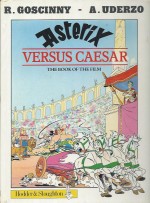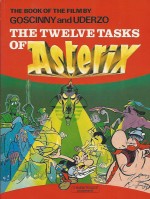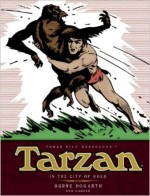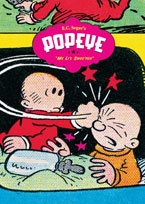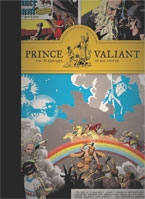
By Roy Crane & various (Fantagraphics Books)
ISBN: 978-1-60699-499-3
Modern comics evolved from newspaper comic strips, and these pictorial features were, until relatively recently, utterly ubiquitous. Hugely popular with the public and highly valued by publishers who used them as an irresistible weapon to guarantee sales and increase circulation, the strips seemed to find their only opposition in the short-sighted local paper editors who often resented the low brow art form, which cut into advertising and frequently drew complaint letters from cranks…
It’s virtually impossible for us today to understand the overwhelming allure and power of the comic strip in America (and the wider world) from the Great Depression to the end of World War II. With no television, broadcast radio far from universal and movie shows at best a weekly treat for most folk, household entertainment was mostly derived from the comics sections of daily and especially Sunday Newspapers. “The Funnies†were the most universally enjoyed recreation for millions who were well served by a fantastic variety and incredible quality of graphic sagas and humorous episodes over the years.
From the very start comedy was paramount; hence the terms “Funnies†and “Comicsâ€, and from these gag and stunt beginnings – a blend of silent movie slapstick, outrageous fantasy and the vaudeville shows – came a thoroughly entertaining mutant hybrid: Roy Crane’s Wash Tubbs.
Debuting on April 21st 1924, Washington Tubbs II was a comedic, gag-a-day strip which evolved into a globe-girdling adventure serial. Crane produced pages of stunning, addictive high-quality yarn-spinning for years, until his eventual introduction of moody swashbuckler Captain Easy ushered in the age of adventure strips with the landmark episode for 6th May, 1929.
This in turn led to a Sunday colour page that was possibly the most compelling and visually imaginative of the entire Golden Age of Newspaper strips (see Roy Crane’s Captain Easy, Soldier of Fortune: The Complete Sunday Newspaper Strips volumes 1-4).
Practically improving minute by minute, the strip benefited from Crane’s relentless quest for perfection: his imaginative, fabulous compositional masterpieces achieved a timeless immediacy that made each page a unified piece of sequential art. The influence of those pages can be seen in the works of near-contemporaries such as Hergé, giants-in-waiting like Charles Schulz and comicbook masters such as Alex Toth and John Severin ever since.
The material was obviously as much fun to create as to read. In fact, the cited reason for Crane surrendering the Sunday strip to his assistant Les Turner in 1937 was NEA/United Features Syndicate’s abrupt and arbitrary demand that all its strips must henceforward be produced in a rigid panel-structure to facilitate their being cut up and re-pasted as local editors dictated.
They just didn’t lift the artist any more so Crane stopped making them.
At the height of his powers Crane just walked away from the astounding Captain Easy Sunday page to concentrate on the daily feature, and when his contract expired in 1943 he left United Features, lured away by that grandee of strip poachers William Randolph Hearst.
The result was a contemporary aviation strip set in the then still-ongoing World War II: Buz Sawyer.
Where Wash Tubbs was a brave but largely comedic Lothario and his pal Easy a surly, tight-lipped he-man, John Singer “Buz†Sawyer was a joyous amalgam of the two: a good-looking, popular country-boy who went to war because his country needed him…
Buz was a fun-loving, skirt-chasing, musically-inclined pilot daily risking his life with his devoted gunner Rosco Sweeney: a bluff, brave and simply ordinary Joe – and one of the most effective comedy foils ever created.
The wartime strip was – and still is – a marvel of authenticity: picturing not just the action and drama of the locale and situation but more importantly capturing the quiet, dull hours of training, routine and desperate larks between the serious business of killing and staying alive. However when the war ended the action-loving duo – plus fellow pilot and girl-chasing rival ChiliHarrison – all went looking for work that satisfied their penchant for adventure and romance wherever they could find it…
Crane was a master of popular entertainment, blending action and adventure with smart drama and compellingly sophisticated soap opera, all leavened with raucous comedy in a seamless procession of unmissable daily episodes.
He and his team of creative assistants – which over the decades comprised co-writer Ed “Doc†Granberry and artists Hank Schlensker, Clark Haas, Al Wenzel, Joel King, Ralph Lane, Dan Heilman, Hi Mankin and Bill Wright) – soldiered on under relentless deadline pressure, producing an authentic and exotic funny romantic thriller rendered in the signature monochrome textures of line-art and craftint (a mechanical monochrome patterning effect used to add greys and halftones to the superb drawing for miraculous depths and moods) as well as the prerequisite full-colour Sunday page.
This primarily black-&-white tome contains an impressive selection of those colour strips – although Crane came to regard them only as a necessary evil which plagued him for most of his career…
The eternal dichotomy and difficulty of producing Sunday Pages (many client papers would only buy either Dailies or Sunday strips, but not both) meant that most creators had to produce different story-lines for each feature – Milt Caniff’s Steve Canyon being one of the few notable exceptions.
Whereas Dailies needed about three weeks lead-in time, hand-separated colour plates for the Sabbath sections meant the finished artwork and colour guides had be at the engravers and printers a minimum of six weeks before publication.
Crane handled the problem with typical aplomb; using Sundays to tell completely unrelated stories. For Wash Tubbs he created the prequel series starring Captain Easy in adventures set before the mismatched pair had met, whilst in Buz Sawyer he turned the slot over to Roscoe Sweeney for lavish gag-a-day exploits, big on slapstick laughs and situation comedy.
During the war years it was set among the common “swabbies†aboard ship: a far more family-oriented feature and probably much more welcome among the weekend crowd of parents and children than the often chilling or disturbing realistically sexy sagas that unfolded Mondays to Saturdays.
A year before Steve Canyon began, Crane tried telling a seven-days-a-week yarn in Buz Sawyer – with resounding success, to my mind, and you can judge for yourself here – but found the process a logistical nightmare. At the conclusion he retuned to weekday continuity whilst Sundays were restored to Roscoe with only occasional guest-shots by the named star.
This second lush and sturdy archival hardback re-presents the tense and turbulent period from October 6th 1945 to July 23rd 1947 wherein de-mobilised adrenaline addict Buz tries to adjust to peacetime life whilst looking for a job and career – just like millions of his fellow ex-servicemen…
Before getting out, he had returned home on leave and ended up accidentally engaged. Buz was the son of the town’s doctor; plain, simple and good-hearted. In that ostensibly egalitarian environment the school sporting star became the sweetheart of ice-cool and stand-offish Tot Winter, the richest girl in town,
Now when her upstart nouveau riche parents heard of the decorated hero’s return they hijacked the homecoming and turned it into a publicity carnival. Moreover the ghastly, snobbish Mrs. Winter conspired with her daughter to trap the lad into a quick and newsworthy marriage.
Class, prejudice, financial greed and social climbing were enemies Buz and Sweeney were ill-equipped to fight, but luckily annoying tomboy-brat girl-next-door Christy Jameson had blossomed into a sensible, down-to-earth, practical and clever young woman.
She’d scrubbed up real pretty too and showed Buz that his future was rife with possibility. Mercifully soon, the leave ended and he and Sweeney returned to the war. The Sawyer/Winter engagement fizzled and died…
When their discharge papers finally arrived (in the episode for September 9th 1945) an era of desperate struggle was over. However that only meant that the era of globe-girdling adventure was about to begin…
Before the comics wonderment resumes, Jeet Heer and Rick Norwood take some time here discussing ‘The Perfectionist and his Team’. Concentrating initially on ‘After the War’ the fascinating explorations then delve deep into the detail of the artist’s troubled and tempestuous relationship with ‘Crane’s Team’ before offering ‘A Word on Comic Strip Formats’ and the censorious iniquities local newspaper editors would regularly inflict upon Crane’s work…
With all the insightful stuff over, the cartoon adventure begins anew as the newly civilian Mr. Sawyer goes home to a life of indolence before his own restless nature starts him fretting again. The old town isn’t the same. Tot has inherited her father’s millions and moved to New York and even Christy is gone: away attending his old alma mater…
After a brief interlude wherein he visits the cheery Co-Ed and debates the merits of returning to college on the G.I. Bill, Buz instead opts for fulltime employment and heads to the Big Apple where Chili Harrison has a new job offer and an old flame waiting.
As he heads East, Buz chooses to ignore his instincts and the huge mysterious guy who seems to turn up everywhere he goes…
In NYC the aloof, alluring Tot is the cream of polite “arty†society but her wealth and clingy new fiancé – opera singer Count Franco Confetti – are all but forgotten when “the one who got away†hits town and she finds her interest in her High School beau rekindled.
Buz has moved in with Chili, blithely unaware that the strange and ubiquitous giant has inveigled himself into the apartment next door and is now actively spying on him…
Sawyer wants a job flying but is only one of hundreds of war-hero pilots looking for a position at International Airways. Moreover his reputation as a hot-shot risk-taker makes him the last person a commercial carrier might consider. However after well-connected Chili intercedes with a major player in the company – something does come up…
The truth about Buz’s hulking stalker comes out when the Maharani of Batu‘s yacht docks in New York. The exotic Asian princess is one of the wealthiest women on Earth and cuts a stunning figure with her tiger on a leash. However when Buz first met her she was simply “Sultryâ€: a ferocious, remorseless resistance fighter helping him kill the occupying Japanese on her Pacific island.
She never forgot him and will ensure no other woman can have him…
Sultry moves into the penthouse adjoining Tot’s and is witness to the ploys of the Winter woman as she sidelines Confetti and makes a play for Buz. She is also a key figure in the tragic heiress’ sudden death…
Just prior to Tot’s gruesome demise Buz had finally met the unconventional Mr. Wright of International Airways. The doughty executive had no need for pilots but wanted a quick-thinking, capable fighter who could solve problems in the world’s most troubled conflict zones. He even has a spot open for good old Roscoe Sweeney…
Buz is all set for his first overseas assignment when the cops decide he’s the other prime suspect in Tot’s murder and, with Sawyer and Count Confetti in jail, Sultry tries to flee America before the truth comes out.
However Sweeney and the freshly exonerated Buz soon track her down, but Sultry turns the tables on them and shanghais her erstwhile lover, imprisoning him on her yacht, determined to make him her permanent boytoy, far, far away from American justice…
Never short of an idea and blessed with the luck of the damned, Buz’s escape results in a terrifying conflagration and the seeming death of his obsessed inamorata – but Sultry’s body isn’t recovered…
It takes a lot of pleading to get Mr. Wright to give him another chance but, soon after, Buz and Sweeney are winging north to Greenland to stop a crazed sniper taking pot-shots at aircraft passing over the “Roof of the Worldâ€.
This savage, visceral extended saga soon reveals the shooter to be a deranged leftover Nazi and his hapless attendants, but the heroes’ astonishing hunt for and capture of the Teutonic trio is as nothing compared to the harrowing trek to get them back to civilisation: especially since poor Roscoe is putty in the hands of Frieda, beautiful devil-daughter of the utterly mad Baron von Schlingle.
Before Buz get the survivors home safely, he loses his plane, has to forcibly trek across melting floes, gets them all stranded on a iceberg and even has his pretty-boy face marred forever…
Worst of all by the time he gets back to civilisation his job no longer exists. Mr. Wright has quit and moved on to another company…
It’s not all bad news: Wright has euphemistically become “Personnel Director†for Frontier Oil, a truly colossal conglomerate active all over Earth and wants Buz to carry on his unique problem-solving career for his new employers.
Despite a large bump in salary, the weary war hero is undecided – until he hears Christy is helping her father in the Central American nation of Salvaduras in his role as a geologist for Frontier Oil. This happily ties in with an outstanding missing persons case; said vanished victim being Bill Daniels, playboy son of a prominent company executive.
It takes very little to convince Wright to despatch Buz and Roscoe south of the border to investigate, opening the floodgates to a spectacular epic of light-hearted romantic adventure a world apart from the previous harrowing tale…
The story also saw Crane and Co. merging the Daily and Sunday strips into a single storyline (with the Sundays primarily illustrated by Schlensker) as the boys tried to trace the missing American in a country that seems locked in fear and poverty…
After initially hitting a wattle-and-daub wall, Buz takes time off for a picnic with Christy and, after a close call with a faux Mexican bandit (in actuality a Yankee fugitive from justice with an atrocious fake accent), declares his undying lover for her.
He is not rebuffed and there’s the hint of wedding bells in the air…
First however he and Sweeney need to finish their mission, and help comes from a brave peon who breaks the regional code of silence to put them on the trail of the mysterious Ranch of the Caves and its American émigré who runs the isolated canton with blood and terror.
After romancing the daughter of vicious “Don Jaime†Buz and Roscoe infiltrate the desolate fiefdom and the gang boss’ international band of thugs, discovering not only the very much alive missing playboy but an incredible lost Mayan treasure trove…
Mission accomplished, Buz returns to New York to marry Christy, only to find he’s already needed elsewhere. Christy too is having doubts, worried that she will always play second fiddle to her man’s lust for action, whereas in truth the real problem is that trouble usually comes looking for Buz…
Boarding a Frontier plane for the Yukon, Sawyer is merely a collateral casualty when the ship’s other passenger is kidnapped. The mysterious men abducting plastic surgeon Dr. Wing take their helpless hostages all the way to deepest Africa where they expected the medic to change the face of an infamous madman everybody in the world believes died in a Berlin Bunker…
Tragically the fanatics are not prepared for the physician’s dauntless sense of duty and sacrifice nor Buz’s sheer determination to survive…
The latter part of this tale describes Buz’s epic river trek with mercenary turncoat honey-trap Kitty as they flee from the vengeful Nazis, but even after reaching the coast and relative safety the insidious reach of the war-criminals is not exhausted and one final attack looms…
Eventually Buz returns to New York alone and wins time from the slave-driving Mr. Wright to settle things with Christy. He follows her to Nantucket Sound but even their romantic sailboat ride turns into a life-changing adventure…
This splendid collection is the perfect means of discovering – or reconnecting with – Crane’s second magnum opus: spectacular, enthralling, exotically immediate romps that influenced generations of modern cartoonists, illustrators, comics creators and storytellers.
Buz Sawyer ranks amongst the very greatest strip cartoon features ever created: stirring, thrilling, outrageously funny and deeply moving tale-telling that is irresistible and utterly unforgettable.
Buz Sawyer: Sultry’s Tiger © 2012 Fantagraphics Books, all other material © 2012 the respective copyright holders. All Strips © 2010 King Features Syndicate, Inc All rights reserved.


